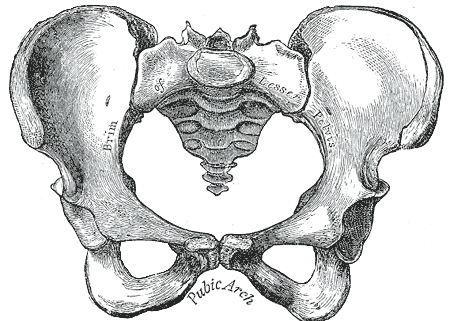Pelvic Floor Manual Therapy:
Care for the Very Core of You
What Is the Pelvic Floor
And What Does it Do?
The pelvic floor is a complex interconnected system of muscles inside everyone's pelvis. It dynamically works to support and stabilize your pelvic organs, allow sexual function, contract firmly and steadily around pelvic openings to prevent urinary and rectal leakage, facilitate lymphatic flow, aid in posture, and also assist with breathing. Pretty big job, right? And for many people, it does all those jobs regularly and without complaint.
But sometimes, due to injury, childbirth, trauma, underlying medical conditions, or even just postural and lifestyle stress like sports or too much sitting, our pelvic floor muscles can either get overly tight, or they can be weak. Some people have a combination: some pelvic floor muscles are weak and others are too tight. Any of these imbalances can have repercussions for our bodies.

What's This Work For?
Some Reasons People Choose Pelvic Floor Manual Therapy:
Pelvic Pain, Including:
- Dyspareunia/ pain with sex
- Interstitial Cystitis/ Painful Bladder Syndrome
- Dysmenorrhea/ painful menstruation
- Endometriosis
- Vulvodynia or other genital pain
- Perineal pain or rectal pain
- Prostatitis
- Painful scar tissue from trauma, childbirth, or surgery
Bladder Concerns, Such As:
- Incontinence/ leaking urine, especially when you cough, sneeze, run, etc, or when your bladder feels full
- Urinary urgency/ sudden urge to pee without much warning
- Urinary frequency/ peeing more often than you'd like
Other Symptoms, Including:
- Pelvic organ prolapse
- Any lower back or hip pain that persists despite other manual treatments. Sometimes tight muscles, fascial tension, and trigger points cause pain that radiates to other areas of the body.
So What Exactly Do We DO?
About Pelvic Floor Manual Therapy
There are other types of treatments for the conditions listed above, but in many cases, a lot of progress can be made by addressing muscle function. Some of these muscles can be accessed externally, and others are best treated internally, either vaginally* and/or rectally. Because everything's connected, depending on your symptoms, we will also evaluate and treat muscle imbalances in the abdomen, hips and thighs. Pelvic floor therapeutic techniques include trigger point release, myofascial unwinding, breath work, and help with muscle activation and retraining. We might also discuss "mind over bladder" strategies to help with urinary symptoms.
Some clients won't be ready for internal exams or treatment at first, either due to physical pain or just not emotionally ready, and for these folks, we might work on external muscles for a while. It's ALWAYS up to you whether and when we do internal work. Other clients might be ready for internal work on our first session. There's no right way.
If you suspect that your pelvic floor might need some attention, please feel free to contact me.
* In my practice, I use your preferred words for your anatomy. For the sake of universal clarity, however, I have decided to use traditional anatomical terms for written descriptions on my website.
I work with folks of all genders and pelvic configurations. Feel free to check out my page about Pelvic Floor Work for Trans Folx.
Supporting your pelvic floor from preconception through the postpartum
Pelvic Floor Manual Therapy for the Childbearing Year
Your reproductive organs function best with a full and easy blood supply. Muscle restrictions and trigger points can reduce blood flow and lead to pelvic congestion. Manual therapy can relieve restrictions and improve blood flow to tissues and organs.
Fertility:
Preparing for Pregnancy
Some folks seek out pelvic floor balancing as part of their plan to optimize fertility. If this is your goal, you'll love the pelvic floor add-on to my Whole Fertility Integrative Bodywork & Guidance sessions, where we can also go over the basics of conception, discuss herbal allies, and review your cycle charts.
Pregnancy:
Planning for Birth?
Fabulous. Did you know your pelvic floor has to soften and open in a coordinated way to allow a baby to descend? Let's work out any tight areas in your pelvic floor and teach you how to intentionally soften it during labor, with Birthing Pelvis, my Prenatal Pelvic & Fetal Alignment package.
Postpartum:
Pelvic Floor After Baby
This is the time most folks think of pelvic floor care. I see postpartum clients starting at 6 weeks!
My Pelvic Floor Education
My foundational education is in midwifery and massage therapy, and I access skills from both every day in this work. For the specifics of pelvic floor manual therapy, I consider my primary training path to be with Herman & Wallace Pelvic Rehabilitation Institute. Their entire focus is pelvic floor and pelvic pain-specific continuing ed classes. Their programs are primarily geared toward physical therapists, but my dual certification allows me special access to their classes. Administrators and instructors have expressed appreciation at the experience and perspective I bring to the field. Read more about my pelvic floor training.
Pelvic Floor Rates, Service Area, & Other Logistics
Our first session includes a thorough intake, and lasts an hour and a half to two hours, for $200. Follow-up sessions are scheduled for an hour, for $150. I typically do visits in your own home, for your ease and comfort, within the Portland area. We can also arrange a quiet studio space if you prefer. If you'd like to sign up for pelvic floor evaluation and treatment, here are some of your options. Since this work is often done when there's a specific concern, it would be typical to have several sessions, so I have package options. That said, I know many folks want to see what this work is all about before signing up for three, so I offer sessions individually as well. Feel free to contact me with any questions you may have beforehand.